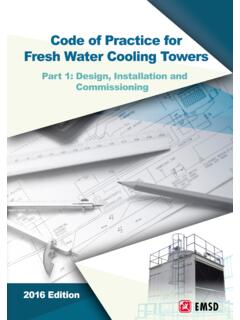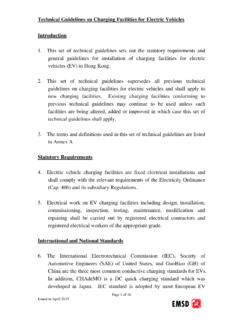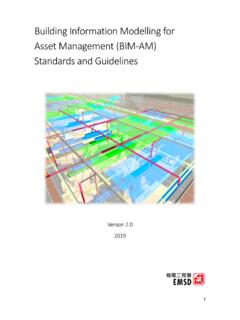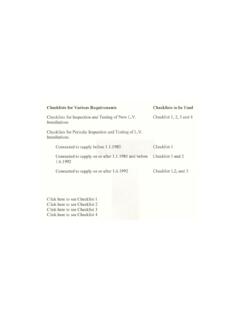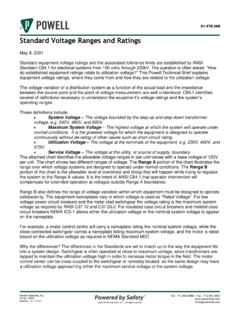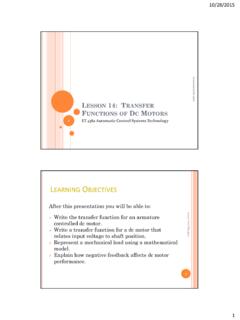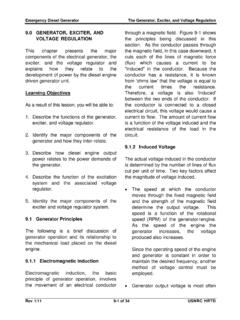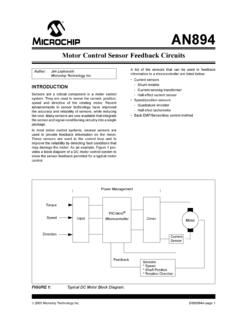Transcription of Report on International Efficiency Efficiency Classes for ...
1 1of 13 Report on Study on International Efficiency (IE) Efficiency Classes for Low voltage AC Motors Executive Summary In Hong Kong, the Code of Practice for energy Efficiency of Building Services Installation (Code of Practice) specifies the minimum motor Efficiency for single-speed three-phase totally enclosed motor . These requirements serve to determine the baseline energy performance on motor . Internationally, there is a standard which stipulates the energy Efficiency of low voltage AC motors, namely the International Efficiency (IE). The purpose of which is to promote higher energy Efficiency to reduce the energy consumption and the energy cost of low voltage AC motors. To facilitate the procurement of new motors with higher energy Efficiency , a study on the IE and its application was conducted. In this paper, the IE standard for motors is introduced. In addition, with a view to better understand the availability of existing motor products in the market, a survey was conducted on the motor and its price of different Classes from major suppliers in Hong Kong.
2 A case study on calculating the energy saving of replacement of energy efficient motor is covered. Background In 1998, the European Committee of Manufacturers of Electrical Machines and Power Electronics (CEMEP) developed three Classes ( EFF1, EFF2 and EFF3) to describe the energy Efficiency of motors. It is a voluntary agreement between the electrical motor manufacturers and the European Commission. However, the agreement expired on 16 June 2011. CEMEP s EFF has been adopted in Europe and some other countries around the world. In order to harmonize the standards describing motor energy Efficiency , the International Electrotechnical Commission (IEC) has developed the International Efficiency (IE) Classes through collaboration with the National Electrical Manufactures Association (NEMA), CEMEP, the Japan Electrical Manufacturers Association (JEMA), the Institute of Electrical and Electronics Engineers (IEEE) and other International organizations.
3 The IE Classes were initially developed in October 2008, namely IEC 60034-30:2008, 2of 13which has been recently updated in June 2014, namely IEC 60034-30-1:2014, for the purpose of expanding its scope of classification. EFF Classification The EFF has 3 Classes , EFF1, EFF2 and EFF3 respectively. EFF1 is the most energy efficient, while EFF3 is the least energy efficient. In other words, the lower class number represents the higher motor Efficiency . The testing method is based on IEC 60034-2-1:1996 Standard methods for determining losses and Efficiency from tests (excluding machines for traction power). The stray load loss, which varies with the load, is assumed at of the motor s input power. However, it is lower than the real losses from motors of lower rated power. IE Classification The IE Classification is defined by IEC 60034-30-1. The latest version of IEC 60034-30-1 was published in June 2014.
4 The IE Classes are shown in Table 1 Table 1 IE Classes Class Type Class Number Standard Efficiency IE1 High Efficiency IE2 Premium Efficiency IE3 Super premium Efficiency IE4 IE4 represents the highest energy Efficiency whilst IE1 represents the least energy Efficiency . In other words, the higher the class number, the higher the motor Efficiency . IE5 is to be incorporated in the next edition of IEC 60034-30-1, with a goal to obtain an energy loss reduction of 20% relative to IE4. However, it should be noted that the drafting of the IE5 is in progress, thus, it is not available in the commercial market now. The scope of classification is defined for single speed, single and three phase, and continuous duty electric motor with 2, 4, 6 or 8 poles. The rated output ranges from to 1,000 kW; the rated voltage is up to 1kV; and the frequency is between 50Hz and 60Hz.
5 The scope also includes ambient temperature within the range of -20oC to +60oC and an altitude of up to 4,000m above sea level. 3of 13 Some particular exemptions are highlighted as follows: Single-speed motors with 10 or more poles or multi-speed motors are excluded; Motors that are completely integrated into a machine, such as a pump, fan and compressor, and frequency-converters that cannot be tested for its Efficiency individually shall be excluded from the IE standard; Brake motors, which is an integral part of the inner motor construction, cannot be removed nor supplied by a separate power source during the test shall be excluded; and Submersible motors and smoke extraction motors with a temperature class above 400oC shall be excluded. In accordance with the Hong Kong electricity supply context, 50Hz motor is the focus. It is observed that the motors commonly used in Hong Kong are 4-poles. A graphical presentation of this type of motor is shown in Figure 1 while the minimum energy Efficiency requirement of IE Efficiency Class of IE1 to IE4 of different poles is shown in Table 2.
6 Figure 1 Minimum Energy Efficiency Requirement of IE Efficiency Class of 4 poles, 50Hz motor 4 of 13 Table 2 Minimum Energy Efficiency Requirement of IE Efficiency Class IE1 to IE4 for 50 Hz motors RatedPower(kW) (50Hz)IE2 (50Hz)IE3 (50Hz)IE4 (50Hz) 5of 13 European Union Practice According to European Union, the IE Classes are implemented progressively. Below is the summary of requirements of energy Efficiency of motor in EU. Table 3 Summary of requirements of energy Efficiency of motor in EU Commencement Date Requirements 16 June 2011 IE2 is the minimum Efficiency class allowed to be newly marketed in the European Economic Area. New motors of IE1 are no longer allowed. 1 January 2014 IE3 is the minimum Efficiency class for motors with a rated output between and 375kW. IE2 is also allowed if motors are operated or equipped with variable speed drive (VSD). 1 January 2017 The scope of requirement of IE3 and IE2 with VSD will be expanded to motors with a rated output from to 375kW.
7 Comparison on EFF/ IE standards The following comparison is based on the testing method of IEC 60034-2-1:1996 for EFF and IEC 60034-2-1:2014 for IE. Study findings of the testing methods reveal that the determination of stray load loss is the major difference. For EFF, the stray load loss is assumed to be of the total power output; whilst for IE, the stay load loss is determined by indirect measurement. It should be noted that in reality, the actual stray load loss is usually higher than of the total power output, especially for motors of lower power. It is obvious that the energy Efficiency of the motors with lower power were overestimated. The EFF and IE Classes could be aligned with each other. The motor of EFF1 could be considered as equivalent to that of IE2, and the motor of EFF2 could be considered as equivalent to that of IE1. Although discrepancies in energy Efficiency requirements can be found between EFF1 and IE2 and EFF2 and IE1, they are due to the difference in the testing method as mentioned above.
8 Table 4 describes the alignment of the energy Efficiency of EFF and IE, and Table 5 compares the energy Efficiency requirement of EFF and IE for 4-poles, 50Hz motor . 6of 13 Table 4 Alignment of the energy Efficiency standard of CEMEP and IEC Efficiency Class IEC CEMEP Super Premium Efficiency IE4 - Premium Efficiency IE3 - High Efficiency IE2 EFF1 Standard Efficiency IE1 EFF2 Below Standard Efficiency - EFF3 Table 5 Comparison of IE and EFF for 4 poles 50Hz motors Rated Power (kW) Comparison between IE2 and EFF1 Comparison between IE1 and EFF2 IE2 EFF1 IE1 EFF2 3 4 11 15
9 22 30 37 45 55 75 90 The IE standard is continuously developing for the future Efficiency Classes .
10 As mentioned above, the IE5 is currently under preparation so the IE classification is expandable for future but the EFF classification is not. 7of 13 Requirements in Hong Kong In accordance with the latest Building Energy Code1 (BEC), the minimum energy Efficiency requirements of motors with rated output not exceeding and above are IE2 and IE3 respectively. Application Area Low voltage motors are widely installed in various E&M appliances, such as the compressors of chillers, AHUs, lifts and pumps. Installing energy efficient motors can help to reduce the electricity consumption. During the procurement of the afore-mentioned electric appliances, apart from looking at the specific energy Efficiency Classes of the electric appliances, further attention could be paid to the energy Efficiency of the motor . For example, when procuring a water pump, the energy Efficiency of the motor equipped within the pump could significantly affect the overall energy Efficiency .


